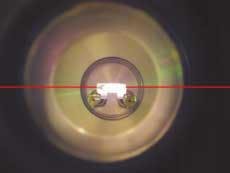In a Rydberg atom (or molecule), an outer electron is excited to a high quantum state without being ionized, resulting in an atom with a very large electron cloud. Rydberg matter (condensed Rydberg atoms or molecules) can be created by desorbing alkali metals from nonmetal surfaces.1 A group led by Leif Holmlid at Göteborg University (Göteborg, Sweden) is now using Rydberg matter as the active medium for a laser, producing a device that is widely tunable in the IR.2, 3 The excitation of the laser is entirely thermal.
While the 0.5-m-long laser cavity itself—defined by a grating and a concave partially reflecting mirror—is ordinary, its inner workings are not. Within the cavity is a vacuum chamber; inside the chamber, a platinum "boat" holds small cylinders of an iron oxide catalyst impregnated with potassium. A leak valve admits a small amount of air into the chamber. When the platinum boat is heated until it glows red, a Rydberg-matter cloud forms from the potassium in the cylinders and the nitrogen in the air, forming the gain medium.
The zinc selenide (ZnSe) chamber windows are antireflection-coated for a 2.5- to 13-µm wavelength range; one window is slightly angled to avoid reflections between the other windows. For shorter wavelengths, the ZnSe windows are exchanged for quartz. The spectrometer-controlled grating is rotated to select the output wavelength. The grating is interchangeable between 75-, 150-, and 300-mm-1 versions. Tilted etalons can be introduced into the cavity by the grating to reduce gain and sharpen band maxima and higher-order diffraction. Although potential short-wavelength edges of different Rydberg-matter bands for potassium range from 205 nm to 10.6 µm, the visible wavelengths were considered unlikely to appear because of the low quantum numbers involved.
Various detectors were used to measure the output, depending on the emission wavelength. A silicon photodiode covered the 190- to 1100-nm range, an indium gallium arsenide p-i-n diode covered the 900- to 1700-nm region, and a mercury cadmium telluride detector handled the mid-IR range of 1500 nm to 14 µm. Measuring the output signal as a function of grating angle produced a spectral output scan.
Tunable from near- to mid-IR
As predicted, the laser produced no light in the visible. For the grating with a line density of 300 mm-1, nine near-IR peaks were observed between the wavelengths of 899 and 1665 nm. The gain of the laser medium was measured to be greater than 100 m-1. Emission in the mid-IR was observed out to almost 16 µm (the longest-wavelength band has a short-wavelength edge of 10.6 µm and peaks at 12.4 µm).
In all, the laser covers the range of 800 nm to almost 16 µm with a few gaps in the near-IR range. The laser transitions occur from upper-level quantum numbers of 40 to 80 down to lower levels of 6 to 21. The appearance of the near-IR gaps confirms that the laser, while thermally pumped, produces light that is a result of nonthermal processes, say the researchers.
The first-generation version of the laser reaches an optical power of 40 µW. Now that the manner in which thermal power is transported into the active medium is better understood, reaching higher power levels should be straightforward, says Holmlid.
The laser is already finding use in practical applications. Holmlid notes that his group is using it for spectroscopy with good results. "One of the standard methods used in the chemical industry for chemical analysis is IR spectroscopy with a thermal broadband source, using a fairly expensive spectrometer for spectral resolution," he says. "Environmental and process monitoring uses the same type of system. The Rydberg-matter laser does the job with less expensive equipment (no spectrometer) and over a considerably larger spectral range. With more-powerful Rydberg-matter sources (to be developed), IR spectra may be used for much lower detection levels in analysis."
REFERENCES
- L. Holmlid, J. Phys. Chem. A 102 10636 (1998).
- L. Holmlid, J. Phys. B: At. Mol. Opt. Phys. 37 (2004).
- S. Badiei and L. Holmlid, Chem. Phys. Lett. 376 (2003).

